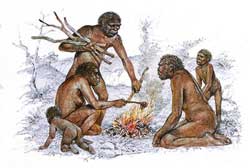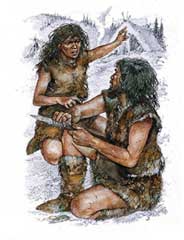|
History Module: Hominization, or The History
of the Human Lineage Chimpanzees are the primates that most closely
resemble human beings genetically. Though we are not descended from chimpanzees,
we do share with them a common ancestor who lived 8 to 10 million years ago.
The series of transformations that primates have undergone since then to
produce the human beings of today are known as hominization. In this process of
hominization, a number of different species have been born and died out. Paleoanthropologists
use the term “hominids” to designate all these past and present human
species.
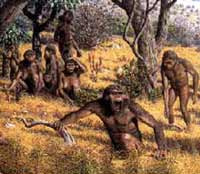 | The
dawn of humanity began in Africa between 6 and 4.5 million years ago. The primates
of that time who are our ancestors may have used very primitive tools, but the
fossil record shows very few traces of human intelligence. |
| Between
4 and 2 million years ago, another hominid genus, Australopithecus,
lived in Africa. Members of this genus walked on two feet, had larger brains than
monkeys of the same size, and ate mainly plants. In 1974, a complete skeleton
of an adult female Australopithecus was discovered in Ethiopia. This
famous specimen has been nicknamed “Lucy”. | 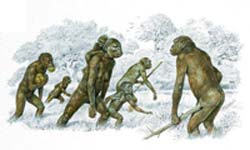 |
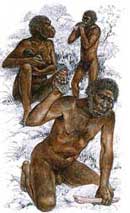 | Around
2 million years ago, the line of the genus Homo made its official appearance
with the species Homo habilis. This species manufactured various
crude tools that it used for purposes such as butchering the animals that it ate
to supplement its plant diet. |
| Homo erectus supplanted
Homo habilis starting about 1.8 million years ago and lived until about
200 000 years ago. Homo erectus had an even larger brain. This species
hunted large herds of animals, had mastered fire, manufactured axes, and spread
from Africa to the tropical and temperate zones of Eurasia. | |
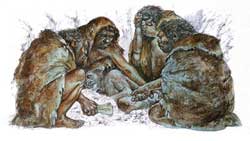 |
About
250 000 years ago, Homo sapiens
neanderthalensis, emerged. These early humans possessed more sophisticated
tools, made of stone and possibly of wood. There is little evidence of Neanderthal
art, science or religion, but the Neanderthals are believed to have buried their
dead (the oldest mortuary site dates back about 100 000 years). Neanderthals were
very strong physically, and they were also excellent hunters. They died out scarcely
30 000 years ago. |
| The Neanderthals’ disappearance
was no doubt somehow related to the spread of the next variety of their species,
Homo sapiens (that is, us). Homo sapiens sapiens
first appeared about 300 000 years ago, and remains of Cro-Magnon man, the European
representative of this group, have been found that date back 35 000 years.
With Homo sapiens sapiens, we see the emergence of specifically human
activities, such as art and religion. These early humans left behind magnificent
cave paintings, the oldest of which, in the Chauvet Cave in France, date back
more than 32 000 years. | |
Over a few tens of thousands of years, Homo sapiens sapiens
conquered every climate region of the Earth. Starting about 10 000 years ago,
agriculture, the domestication of animals, cities, and writing soon followed.
|



